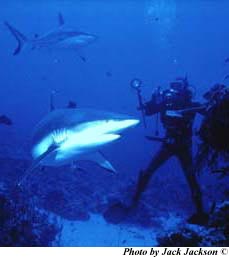 |
In 1998 the International Shark Attack File (ISAF) received 58
reports of shark attack on humans. After investigation, 51 of these
have been assigned to the confirmed "unprovoked attack" category.
Unprovoked attacks are defined as incidents where no human
provocation of the shark preceded the attack upon a live human in
the shark's natural habitat. Shark-inflicted damage to dead humans
(most often drowning victims), incidents occurring out of the water
(usually to fishers handling sharks), and interactions between
sharks and divers in public aquaria or research holding pens are not
considered attacks. Of the remaining 1998 cases, three are
considered the result of human provocation (referred to as
"provoked attacks") and six lacked sufficient information
to categorize the attack.
During the early part of this decade the number of unprovoked
shark attacks grew at a steady rate, rising from 36 in 1990 to an
all-time high of 72 in 1995. More recently, the number has declined
with 40 unprovoked attacks recorded in 1996, 57 in 1997, and 49 in
1998 (see graphic).
The number of shark attacks transpiring in a given year is
directly correlated to the amount of human time spent in the sea. As
the world population continues to upsurge and the time spent in
aquatic recreation rises, we might expect a gradual annual increase
in the number of attacks. By contrast, nearshore shark populations
are declining at a serious rate in many areas of the world as a
result of overfishing, theoretically reducing the opportunity for
shark-human interactions. However, year-to-year variability in local
economic, meteorological and oceanographic conditions also greatly
influences the odds of sharks and humans encountering one another.
As a result, short-term trends in the number of shark attacks must
be viewed with caution.
In 1998, six fatalities were verified as occurring from attacks
in Brazil (two), South Africa, Australia, Mozambique, and Florida
(one each). The annual fatality rate of 12.2% was about equal to the
1990-1997 average of 11.4%.
More than half of the unprovoked attacks (26, including one
fatality) occurred in North American waters. Other regions having
attacks were Africa (19, two fatal); South America (four, two
fatal), Australia (one fatal); and Pacific Ocean islands (one
non-fatal).
The United States had more attacks (24, one fatal) than any other
country. South Africa, which has averaged five unprovoked attacks
per year over the last ten years, had an unusually high total of 18
(one fatal) in 1998. Four attacks occurred in Brazil, including two
fatalities. Australia, the Bahamas, Guadeloupe, and Mozambique had
single attacks.
Florida had 20 unprovoked attacks in 1998, down from the 1997
total of 25 but is consistent with the previous ten-year average of
16 attacks per year. Florida historically has had the highest annual
number of attacks among U.S. states, the result of having a large
aquatically-active population, an enormous transient population of
tourists, a large coastline, and a climate and environment favorable
to year-round aquatic recreation and sharks. The fatality that
occurred in 1998 was its first since 1988 and the first involving
shore-based activity, such as swimming, wading, surfing, and wind
sail-boarding, in 22 years. Single non-fatal attacks also occurred
in California, Hawaii, Louisiana, Oregon and Virginia.
Within Florida, Volusia County had the most (11) shark incidents,
which is largely attributable to high aquatic recreational
utilization of its attractive waters by large numbers of Florida
residents and tourists, especially surfers. Other counties having
attacks in 1997 were Martin (3), Indian River (2), Brevard (1), Lee
(1), and Palm Beach (1).
Surfers continue to constitute the recreational user group most
often subjected to shark attack with more than two-thirds (69%) of
the 1998 attacks targeting this user group. The remaining attacks
occurred equally upon swimmers and waders (15.5%) and divers
(15.5%).
The International Shark Attack File (ISAF) is a compilation of
all known shark attacks that is administered by the American
Elasmobranch Society, a professional organization comprised of
international workers studying sharks, skates and rays, and the
Florida Museum of Natural History. More than 3,100 individual
investigations are currently housed in the ISAF, covering the period
from mid-1500's to present. Many of the data in the ISAF originate
from the voluntary submissions of numerous cooperating scientists
who serve worldwide as regional observers. Data submitted to the
ISAF is screened, coded and computerized. Hard copy documentation,
including original notes, press clippings, photographs, audio/video
tapes, and medical/autopsy reports, is permanently archived. Data in
the ISAF are studied by biological researchers and research
physicians. Access to ISAF data is granted only after careful
screening on a case-by-case basis. Direct access by the press and
general public is prohibited since much data, including medical
records, is sensitive in nature and is given in confidence. Requests
for summary information and non-privileged data are made to the ISAF
director, George H. Burgess. |




